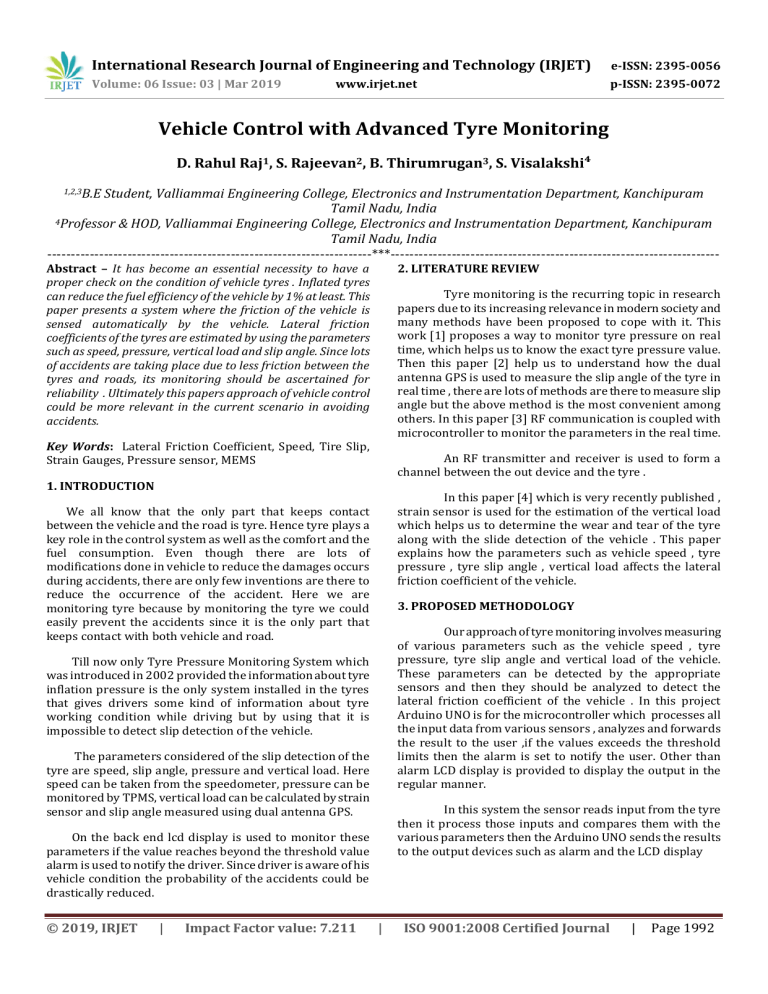IRJET-Vehicle Control with Advanced Tyre Monitoring
advertisement

International Research Journal of Engineering and Technology (IRJET) e-ISSN: 2395-0056 Volume: 06 Issue: 03 | Mar 2019 p-ISSN: 2395-0072 www.irjet.net Vehicle Control with Advanced Tyre Monitoring D. Rahul Raj1, S. Rajeevan2, B. Thirumrugan3, S. Visalakshi⁴ 1,2,3B.E Student, Valliammai Engineering College, Electronics and Instrumentation Department, Kanchipuram Tamil Nadu, India 4Professor & HOD, Valliammai Engineering College, Electronics and Instrumentation Department, Kanchipuram Tamil Nadu, India ---------------------------------------------------------------------***---------------------------------------------------------------------Abstract – It has become an essential necessity to have a proper check on the condition of vehicle tyres . Inflated tyres can reduce the fuel efficiency of the vehicle by 1% at least. This paper presents a system where the friction of the vehicle is sensed automatically by the vehicle. Lateral friction coefficients of the tyres are estimated by using the parameters such as speed, pressure, vertical load and slip angle. Since lots of accidents are taking place due to less friction between the tyres and roads, its monitoring should be ascertained for reliability . Ultimately this papers approach of vehicle control could be more relevant in the current scenario in avoiding accidents. 2. LITERATURE REVIEW Tyre monitoring is the recurring topic in research papers due to its increasing relevance in modern society and many methods have been proposed to cope with it. This work [1] proposes a way to monitor tyre pressure on real time, which helps us to know the exact tyre pressure value. Then this paper [2] help us to understand how the dual antenna GPS is used to measure the slip angle of the tyre in real time , there are lots of methods are there to measure slip angle but the above method is the most convenient among others. In this paper [3] RF communication is coupled with microcontroller to monitor the parameters in the real time. Key Words: Lateral Friction Coefficient, Speed, Tire Slip, Strain Gauges, Pressure sensor, MEMS An RF transmitter and receiver is used to form a channel between the out device and the tyre . 1. INTRODUCTION In this paper [4] which is very recently published , strain sensor is used for the estimation of the vertical load which helps us to determine the wear and tear of the tyre along with the slide detection of the vehicle . This paper explains how the parameters such as vehicle speed , tyre pressure , tyre slip angle , vertical load affects the lateral friction coefficient of the vehicle. We all know that the only part that keeps contact between the vehicle and the road is tyre. Hence tyre plays a key role in the control system as well as the comfort and the fuel consumption. Even though there are lots of modifications done in vehicle to reduce the damages occurs during accidents, there are only few inventions are there to reduce the occurrence of the accident. Here we are monitoring tyre because by monitoring the tyre we could easily prevent the accidents since it is the only part that keeps contact with both vehicle and road. 3. PROPOSED METHODOLOGY Our approach of tyre monitoring involves measuring of various parameters such as the vehicle speed , tyre pressure, tyre slip angle and vertical load of the vehicle. These parameters can be detected by the appropriate sensors and then they should be analyzed to detect the lateral friction coefficient of the vehicle . In this project Arduino UNO is for the microcontroller which processes all the input data from various sensors , analyzes and forwards the result to the user ,if the values exceeds the threshold limits then the alarm is set to notify the user. Other than alarm LCD display is provided to display the output in the regular manner. Till now only Tyre Pressure Monitoring System which was introduced in 2002 provided the information about tyre inflation pressure is the only system installed in the tyres that gives drivers some kind of information about tyre working condition while driving but by using that it is impossible to detect slip detection of the vehicle. The parameters considered of the slip detection of the tyre are speed, slip angle, pressure and vertical load. Here speed can be taken from the speedometer, pressure can be monitored by TPMS, vertical load can be calculated by strain sensor and slip angle measured using dual antenna GPS. In this system the sensor reads input from the tyre then it process those inputs and compares them with the various parameters then the Arduino UNO sends the results to the output devices such as alarm and the LCD display On the back end lcd display is used to monitor these parameters if the value reaches beyond the threshold value alarm is used to notify the driver. Since driver is aware of his vehicle condition the probability of the accidents could be drastically reduced. © 2019, IRJET | Impact Factor value: 7.211 | ISO 9001:2008 Certified Journal | Page 1992 International Research Journal of Engineering and Technology (IRJET) e-ISSN: 2395-0056 Volume: 06 Issue: 03 | Mar 2019 p-ISSN: 2395-0072 www.irjet.net 4.3. FRONT-END DEVELOPMENT The front-end development involved coding with Embedded C in Arduino IDE (Integrated Development Environment). This program helped in indicating the lateral friction coefficient of the tyre , if this value reaches beyond the threshold value then the alarm will be used to warn the driver. 4.4. TESTING AND IMPLEMENTATION Our project implements statistical analysis of the collected data using previously identified effective formulae these formulae helps us to determine the exact value of the lateral friction coefficient of the vehicle. Figure 1: Block diagram of Vehicle Control with Advanced Tyre Monitoring LFC=Fy/Fz 4. ROJECT DEVELOPMENT Where, The development of this project can be explained in four stages. LFC – Lateral Friction Coefficient Fy=C1+(C2*Fz)(1- exp(C3*α)) They are, Where C1=10 1. Research 2. Back-end Development 3. Front-end Development 4. Testing and implementation C2=.889 C3=-1.06 Then the value of Fz can be obtained from the simulation are used to calculate the lateral friction coefficient of the vehicle. 4.1 RESEARCH The efficiency of the system is based on the types of sensors which are used to determine the parameters such as slip angle, tyre pressure and vertical load since these parameters has a direct effect on the lateral friction coefficient of the vehicle. We began the research stage of our project by doing literature review in mutually interested vehicle control domain. We arrived at the idea of our project after we came across many research papers under the topic “Tyre Monitoring”. After that we studied about various parameters that affect the frictional force between the road and the tyre then we decided to monitor those parameters to estimate the lateral friction coefficient of the tyre. This research has helped us in guiding the project itself and in selection of appropriate modules that are beneficial and relevant according to the current technology standards. 5. CONCLUSION As of now, even with our technological advancements, there is no low-cost reliable solution available for tyre monitoring, by implementing this method Lateral Friction coefficient of the tyre can be detected. It increases the safety of the passengers travelling in the vehicle. Here vehicle monitoring can be done in real time. 4.2. BACK-END DEVELOPMENT ACKNOWLEDGEMENT The back-end development stage of our project has involved PHP programming for web development in serverside scripting. This helps in collecting sensor data, generating dynamic page content, and analyzing databases. PHP supports any commonly available OS and most of the web servers available today. So, we utilized it to develop the back-end of our project. For the web server, we used Jemi Cluster, the private web server of Infoziant Technologies Pvt. Ltd. © 2019, IRJET | Impact Factor value: 7.211 We would also like to express our gratitude to the Project coordinator, Mr. K.R. Ganesh, Assistant Professor, and EIE Department of Valliammai Engineering College. We extend our gratitude to our Project Guide and Head of the Department, Dr.S.Visalakshi. Who provided insight and valuable guidance to us. | ISO 9001:2008 Certified Journal | Page 1993 International Research Journal of Engineering and Technology (IRJET) e-ISSN: 2395-0056 Volume: 06 Issue: 03 | Mar 2019 p-ISSN: 2395-0072 www.irjet.net REFERENCES 1. Arashbir Singh Brar ; Ramesh K Sharma ; Alampratap Singh ; Design and Development of Indigenous Tyre Pressure Monitoring System-2016 2. J Ryu,EJ Rossetter ;JC Gerdes ; Veehicle side slip and roll parameter estimation using GPS-2002 3. M Brzeska ; GA Charkam; RF modelling and characterization of a tyre pressure monitoring system-2007-IET 4. Jorge Yunta ; Daniel Garcia Pozuelo ; Vincente Diaz ;A Strain-Based Method to Detect Tires’ Loss of Grip and Estimate Lateral Friction Coefficient from Experimental Data by Fuzzy Logic for Intelligent tyre development -2018 © 2019, IRJET | Impact Factor value: 7.211 | ISO 9001:2008 Certified Journal | Page 1994




